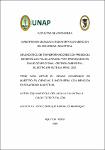| dc.contributor.advisor | Bardales Manrique, Jorge Enrique | |
| dc.contributor.author | Del Aguila Chujutalli, Maricela | |
| dc.contributor.author | Torres Falcón, Cindy | |
| dc.date.accessioned | 2019-03-12T13:55:23Z | |
| dc.date.available | 2019-03-12T13:55:23Z | |
| dc.date.issued | 2018 | |
| dc.identifier.other | 613.62 D53 2018 | es_PE |
| dc.identifier.uri | http://repositorio.unapiquitos.edu.pe/handle/20.500.12737/5936 | |
| dc.description.abstract | Esta investigación pretende orientar sobre las estrategias a aplicar para la gestión ambiental y de salud ocupacional en transformadores de Electro Oriente con presencia de PCB; éstos son elementos contaminantes orgánicos persistentes que no se encuentran en la naturaleza de manera natural, éstos han sido desarrollados producidos por el hombre desde los años 30 del siglo pasado, hasta 1983 se prohibió su producción por ser altamente dañinos para la salud humana y ambiente. El 2002 la Convención de Estocolmo identificó a los PCB como unos elementos contaminantes que requieren atención especial de los países y se comprometieron a su eliminación en un plazo que termina el 2025 para sacar del servicio a equipos con este componente y hasta el 2028 para su eliminación total de los residuos contaminados con PCB. En el Perú este convenio fue ratificado en agosto del 2005.
Esta investigación parte de la hipótesis: “El diseño de estrategias para la gestión ambiental y de seguridad de los Binéfilos Policlorados – PCB’s cpermitirá identificar y controlar los PCB’s en los transformadores de Electro Oriente S.A.”, para demostrar esto se parte de un diagnóstico y análisis de los aceites dieléctricos contenidos en los transformadores de mayor antigüedad de Electro Oriente, normativas legislativas existentes, capacidades analíticas y mecanismos de comunicación que han comprobado la hipótesis. El objetivo es identificar los transformadores contaminados con PCB, determinar los niveles de concentración y plantear estrategias de gestión ambiental y salud ocupacional. En definitiva, se puede concluir que años anteriores no se han tenido avances en el control y eliminación de PCB en la empresa Electro Oriente, con la investigación realizada se puede asegurar que tomando las medidas propuestas será posible reducir sustancialmente el riesgo a los trabajadores, medio ambiente y cumplir con los objetivos establecidos por ELOR, FONAFE y el Convenio de Estocolmo. | es_PE |
| dc.description.abstract | This research aims to guide on the strategies to be applied for environmental and occupational health management in Electro Oriente transformers with the presence of PCBs; These are persistent organic pollutants that are not naturally found in nature, they have been developed by man since the 30s of the last century, until 1983 their production was banned because they are highly harmful to human health and the environment. In 2002, the Stockholm Convention identified PCBs as polluting elements that require special attention from the countries and committed to their elimination in a period that ends in 2025 to remove equipment with this component from service and until 2028 for its elimination. Total waste contaminated with PCB. In Peru, this agreement was ratified in August 2005.
This research is based on the hypothesis: "The design of strategies for the environmental and safety management of Polychlorinated Binéfilos - PCBs will allow the identification and control of PCBs in Electro Oriente SA transformers", to demonstrate this is based on a diagnosis and analysis of the dielectric oils contained in the older transformers of Electro Oriente, existing legislative regulations, analytical capabilities and communication mechanisms that have proven the hypothesis. The objective is to identify the transformers contaminated with PCBs, determine the levels of concentration and propose strategies for environmental management and occupational health. In short, it can be concluded that previous years there has been no progress in the control and elimination of PCB in the company Electro Oriente, with the research carried out it can be assured that by taking the proposed measures it will be possible to substantially reduce the risk to workers, environment and meet the objectives set by ELOR, FONAFE and the Stockholm Convention. | en_US |
| dc.description.uri | Tesis | es_PE |
| dc.format | application/pdf | es_PE |
| dc.language.iso | spa | es_PE |
| dc.publisher | Universidad Nacional de la Amazonía Peruana | es_PE |
| dc.rights | info:eu-repo/semantics/openAccess | es_PE |
| dc.rights | Attribution 3.0 United States | * |
| dc.rights.uri | http://creativecommons.org/licenses/by/3.0/us/ | * |
| dc.source | Universidad Nacional de la Amazonía Peruana | es_PE |
| dc.source | Repositorio institucional - UNAP | es_PE |
| dc.subject | Salud ocupacional | es_PE |
| dc.subject | Prevención | es_PE |
| dc.subject | Transformadores | es_PE |
| dc.subject | Bifenilos policlorados | es_PE |
| dc.title | Diagnóstico de transformadores con presencia de bifenilos policlorados, para prevención en salud ocupacional, gestión ambiental, Electro Oriente S.A, Perú, 2017 | es_PE |
| dc.type | info:eu-repo/semantics/masterThesis | es_PE |
| thesis.degree.discipline | Agronomía | es_PE |
| thesis.degree.grantor | Universidad Nacional de la Amazonía Peruana. Escuela de Posgrado | es_PE |
| thesis.degree.level | Maestría | es_PE |
| thesis.degree.name | Maestro(a) en Ciencias e Ingenieria con mención en Seguridad Industrial | es_PE |
| thesis.degree.program | Regular | es_PE |
| dc.subject.ocde | http://purl.org/pe-repo/ocde/ford#3.03.10 | es_PE |


